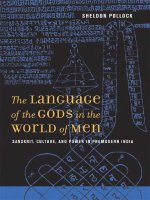japan pop! inside the world of japanese popular culture
Bạn đang xem bản rút gọn của tài liệu. Xem và tải ngay bản đầy đủ của tài liệu tại đây (12.57 MB, 378 trang )
Cover
title: Japan Pop! : Inside the World of Japanese Popular Culture
author: Craig, Timothy J.
publisher: ME Sharpe, Inc.
isbn10 | asin: 0765605600
print isbn13: 9780765605603
ebook isbn13: 9780585383316
language: English
subject Popular culture Japan, Japan Civilization 1945-
publication date: 2000
lcc: DS822.5.J386 2000eb
ddc: 952.04
subject: Popular culture Japan, Japan Civilization 1945-
Page i
JAPAN POP!
Page ii
This page intentionally left blank.
Page iii
JAPAN POP!
Inside the World of Japanese Popular Culture
Timothy J. Craig, Editor
Page iv
An East Gate Book
Copyright © 2000 by M. E. Sharpe, Inc.
All rights reserved. No part of this book may be reproduced in any form without written permission from the publisher, M. E. Sharpe, Inc., 80
Business Park Drive, Armonk, New York 10504.
Library of Congress Cataloging-in-Publication Data
Japan pop! : inside the world of Japanese popular culture / edited by Timothy J. Craig
p. cm.
"An East gate book"
Includes bibliographical references and index.
ISBN 0-7656-0560-0 (alk. paper)
1. popular culture—Japan. 2. Japan—Civilization—1945- I. Craig, Timothy J., 1947-
DS822.5 .J386 2000
952.04—dc21 00-021812
Printed in the United States of America
The paper used in this publication meets the minimum requirements of American National Standard for Information Sciences Permanence of
Paper for Printed Library Materials, ANSI Z 39.48-1984.
BM (c) 10 9 8 7 6 5 4 3 2
Page v
Contents
Acknowledgments vii
A Note on Language ix
1. Introduction
Tim Craig
3
Part I. Popular Music
2. Can Japanese Sing the Blues? "Japanese Jazz" and the Problem of Authenticity
E. Taylor Atkins
27
3. The Marketing of Tears: Consuming Emotions in Japanese Popular Song
Christine R. Yano
60
4. Open Your File, Open Your Mind: Women, English, and Changing Roles and Voices in Japanese Pop Music
James Stanlaw
75
5. A Karaoke Perspective on International Relations
Hiro R. Shimatachi
101
Part II: Comics and Animation
6. Japanese Comic Books and Religion: Osamu Tezuka's Story of the Buddha
Mark Wheeler MacWilliams
109
7. The Romantic, Passionate Japanese in Anime: A Look at the Hidden Japanese Soul
Eri Izawa
138
8. Hadashi no Gen (Barefoot Gen): Volume 8, pages 17–31
Keiji Nakazawa
154
Page vi
9. Gender Roles and Girls' Comics in Japan: The Girls and Guys of Club
Maia Tsurumi
171
10. From Sazae-san to Crayon Shin-chan: Family Anime, Social Change, and Nostalgia in Japan
William Lee
186
Part III: Television and Film
11. New Role Models for Men and Women? Gender in Japanese TV Dramas
Hilaria M. Gössmann
207
12. A New Kind of Royalty: The Imperial Family and the Media in Postwar Japan
Jayson Chun
222
13. Into the Heartland with Tora-san
Mark Schilling
245
Part IV: Japanese Popular Culture Abroad
14. Sailor Moon: Japanese Superheroes for Global Girls
Anne Allison
259
15. Beauty Fighter "Sailor Chemist"
Yuka Kawada
279
16. Doraemon Goes Abroad
Saya S. Shiraishi
287
17. Pop Idols and the Asian Identity
Hiroshi Aoyagi
309
About the Contributors 327
Credits for Photographs and Illustrations 331
Credits for Song Lyrics 335
Index 339
Page vii
Acknowledgments
Like most books, this one benefited from the help and encouragement of a great number of people. I would first like to express my gratitude to the
University of Victoria's Centre for Asia-Pacific Initiatives (CAPI) and to its Director Bill Neilson for the support and resources that allowed me to
take on this project. Along the way, much-appreciated assistance was provided by Stella Chan, Tomoko Izawa, Heather MacDonald, and Wendy
Farwell.
For inspiration in a variety of forms, a tip of the hat to Fosco Maraini, Fred Schodt, Steve Mindel, John, Curtis, and magic Tango. A special word of
appreciation goes to the many publishers and artists in Japan who generously provided permission for the use of photographs, illustrations, and
song lyrics, and to Doug Merwin and M. E. Sharpe, for their enthusiasm for a book concept that other publishers tended to view as either too
academic or not academic enough. And to my wonderful family—Hiroko, Danny, and Emily—thanks for putting up with the project and for helping
me out so much with your ideas and knowledge of Japan pop—I've been lucky to have such a good resource sitting around the dinner table.
Finally, I want to thank all the authors and artists who have contributed their writings and other creations to this volume. Your enchanting and
insightful work has provided the real motivation. From my first encounter with it, I knew that I had something special in my hands, and I have since
been driven, over a sometimes bumpy road, by a desire to share it with a larger audience. I hope you are happy with the destination.
Page viii
This page intentionally left blank.
Page ix
A Note on Language
In Japan, people's names are usually written with the family name first and the given name last. However, as this book is written not just for Japan
specialists but for a more general audience as well, I have listed Japanese names in the usual English order: given name first and family name last.
Japanese words are generally italicized (e.g., yume, namida). An exception is made for words which are used repeatedly in a chapter; such words
are italicized and defined the first time they are used (e.g., enka, anime), and thereafter printed in roman type (enka, anime). A "long sign"
(macron) over a vowel in a Japanese name or word indicates that the sound of the vowel is sustained; thus the difference in pronunciation between
koi (love) and (an act, kind intentions, or goodwill).
In Japanese titles that include "borrowed" English words, I have generally used the standard English spellings of those words rather than
phoneticizing them; thus "Diamonds" instead of Daiamondo and Club rather than Kurabu.
Page x
This page intentionally left blank.
Page 1
JAPAN POP!
Page 2
This page intentionally left blank.
Page 3
1
Introduction
Tim Craig
"Where . . . Where am I? I know I must have drowned, but. . . ."
You have died. Akanemaru has ceased to exist. His body has decayed and dissolved into the sea. . . . Look around you. . . .
"WHAT?!! What is this?! What am I?!"
You are now a microscopic sea creature. You are nothing more than a miserable little speck. The instant your human form ceased to exist, you
were reborn.
"But WHY?! Why have I changed? What have I done to deserve this?"
You didn't do anything wrong. . . . This was simply your destiny—to become something different, when your life as a human ended. . . .
"NO!! I'm a man!! And I want to live like one!! . . . Oh No! Something huge is coming! I'm going to be swallowed!"
—From Phoenix, by Osamu Tezuka1
***
Hey you say you were a butterfly
I see you in a peaceful field
Hey you say you were a butterfly
I see you in a beautiful garden
I wanna catch you catch you catch you
Butterfly Boy
— Knife
***
"Toto, I have a feeling we're not in Kansas anymore."
—Dorothy, in The Wizard of Oz
Page 4
Japan's New Pop Power.
Cartoons and comic books, TV dramas and pop music stars, fashion trends and crooning businessmen—until two decades ago such familiar and
fun areas of life would have been unlikely entries in the journal of images commonly associated with Japan. For the greater part of this century,
Japan presented two very different faces to the outside world. One was the exotic Orient, a land of sword-wielding samurai, kimono-clad geisha,
and Zen Buddhism whose fascination and charm lay in its distance—geographic, temporal, and cultural—from our own everyday worlds. The other
was Japan the power, first military and later economic, whose impact on our lives was closely felt, formidable, and not always pleasant. In the arena
of popular culture, a sphere that is both part of our everyday lives and a source of pleasure, Japan was a very minor player, unless one counts the
televisions, stereos, and videocassette recorders that Japan produced so efficiently and that brought us the cultural products of Hollywood, Disney,
and our various home countries. Although Japan's own postwar pop culture had in fact been creative, vibrant, and commercially successful
domestically, this was a fact that few people outside Japan were aware of. In the international consciousness Japan remained a serious nation and
people, accomplished in traditional arts and modern manufacturing, but hardly a wellspring of entertainment and appealing cultural creations that
would one day spread beyond Japan's shores.
Today it's a different story. Japan's pop culture has not only continued to evolve and blossom at home, it has also attracted a broad, street-level
following overseas, giving Japan a new cultural impact on the world to complement its established economic impact. Japanese animation and
comics have built a huge global following, and their Japanese names, anime and manga, have entered the international lexicon. A new generation
of young Americans, Europeans, and Asians have grown up watching not Mickey Mouse and Bugs Bunny but Japanese cartoons, from Astro Boy,
Speed Racer, Star Blazers, and Robotech to Doraemon, Sailor Moon, Dragon Ball, and Crayon Shinchan. Anime fan clubs, "fanzines," and Web
sites have sprung up by the hundreds, and hit movies such as Akira and Ghost in the Shell have helped Japanese animation gross tens of millions
of dollars in yearly international box office and video sales. Japan's manga (comics) are translated and read eagerly throughout the world, and the
influence of manga's fine lines and realistic aesthetic style can be seen in Western fashion and graphic design.2
Page 5
Recent Japanese films have won top awards at the Cannes and Vienna Film Festivals, while Japan's TV dramas and variety shows are in high
demand throughout Asia. One Hong Kong shop routinely sells fifty video compact discs of a single Japanese TV drama per day, to customers who
want to see the latest episodes as soon as possible.3 Japanese pop singers perform to packed venues in Hong Kong and mainland China, top
"Canto-pop" (Hong Kong pop music) and other Asian recording artists do cover versions of hit Japanese pop songs, and the techno-pop sound of
Japanese music tycoon Tetsuya Komuro provides the sound track for major Hollywood movies. Dreams Come True vocalist Miwa Yoshida graces
the cover of Time magazine, and the all-girl rock group Knife has a strong alternative following in the United States. In Taiwan and Hong
Kong, teenagers take their fashion cues from the clothes of Japanese "idol" singers and TV stars and from Japanese teen magazines such as
Non-No. Gossipy stories about Japanese entertainers such as Takuya Kimura and Noriko Sakai fill local newspapers.4 Among the Nintendo and
PlayStation set, which encompasses most of the school-age population in many countries, Japanese video games such as Street Fighter, Tekken,
and Final Fantasy rule the roost. Karaoke is a household word worldwide, and the parade out of Japan of hit pop culture products like Hello Kitty
goods, Tamagotchi virtual pets, and Pokémon toys is unending. Even in South Korea, where anti-Japan sentiment thrives as a result of Japan's
1910–1945 colonial rule of the Korean peninsula, demand for Japan pop is strong among the younger generation. Japanese music, comics, and
fashion magazines commonly circulate "underground" despite a decades-long ban on the importation of Japanese cultural products, while popular
manga such as Slam Dunk, which set off a basketball craze in South Korea, are translated into Korean, with the names and places changed so
that they can be imported legally.5
In short, Japan pop is ubiquitous, hot, and increasingly influential. Once routinely derided as a one-dimensional power, a heavyweight in the
production and export of the "hard" of automobiles, electronics, and other manufactured goods but a nobody in terms of the "soft" of cultural
products and influence, Japan now contributes not just to our material lives, but to our everyday cultural lives as well.
Why Japan Pop Is Hot
One sign of the level of interest in Japan's pop culture was a conference on the topic held in Victoria, Canada, by the University of Victoria Cen-
Page 6
tre for Asia-Pacific Initiatives in 1997. Launched with a one-page announcement sent to a few Japan specialists and posted on the Internet, the
conference drew a strong international response and evolved into a three-day event featuring over forty presentations by scholars, writers,
practitioners, and fans from four continents on Japanese pop music, comics and animation, TV dramas and commercials, movies, stand-up
comedy, popular literature, and sumo wrestling, as well as issues such as social change, women's roles, and the spread and appeal of Japanese
pop culture overseas.6 In the audience, scholars from Harvard, Stanford, and Tokyo Universities, applying an academic lens to analyze Japanese
society through its popular culture, rubbed shoulders with purple-haired, karaoke-singing otaku (hard-core aficionados) conversant with the latest
pop music groups and manga artists. As diverse a group as one is likely to find at a university conference, all brought valid viewpoints to the subject
and shared both a deep enthusiasm for Japan's popular culture and an appreciation of its growing influence.
The Victoria conference received considerable media coverage, and as its organizer, I found myself being asked the same questions over and
over: What's so special about Japanese pop culture? Why is it gaining such popularity outside Japan? The chapters of this book provide a fuller
answer to that question than I can give here, but in the next few pages I offer some thoughts and insights based on the Victoria conference, the
writings presented in this book, and my own dozen years in Japan as a close follower and fan of Japan's pop culture.
Quality and Creativity
Asked why Japan's pop culture products are now so popular internationally, Hidenori Oyama, director of Animation's International Department,
has a simple answer: "It's because they're high quality, that's all."7 Not all Japan pop is high quality—far from it. Even the most avid fan would
readily admit that Japan's pop culture, like that of any nation, has its share of the mediocre, or worse: mindless television shows, cute but off-key
pop singers, boring mass-produced manga, and the excessively violent and pornographic. Nevertheless, Oyama's bold statement rings true, for
overshadowing the uninspired and the forgettable are numerous examples, in every genre, of artists and works that are outstanding by any
standard in their quality and creative genius.
That Japan, long a land of poets and artists as well as warriors and
Page 7
businessmen, should today excel in an area of the arts should come as no surprise to anyone familiar with the nation's rich aesthetic heritage.
Japan boasts a long and distinguished record of artistic achievement, and more masters and masterpieces than can be named here, in literature,
poetry, theater, film, sculpture, painting, ceramics, gardening, and architecture. The bloodlines of today's popular culture go back in particular to the
vibrant bourgeois culture, born of the common people and aimed at the new urban middle class, which developed and flourished during Japan's
Edo period (1603–1867). The novels of adventure and eroticism produced during this period by writers like Ibara Saikaku burst with the joy of life,
expressing "an unbridled taste for everything pleasurable, amusing, extravagant, sensational."8 In drama, the popular bunraku (puppet) and kabuki
(popular plays with highly stylized singing and dancing) theaters took their place beside the older and more aristocratic (classical dance-drama).
Chikamatsu Monzaemon, the man considered Japan's greatest playwright, wrote for both bunraku and kabuki, and many of his powerful scripts,
which turned simple characters such as shop clerks and prostitutes into tragic figures, remain popular today. This was also the period in which
popularized haiku (seventeen-syllable poems), which Japanese of all classes (and many non-Japanese as well) have written and enjoyed
since time. Still another major art form to emerge from Edo-period mass culture, and perhaps the one best known in the West, is the ukiyo-
e (pictures of the ephemeral world) woodblock print. The delightful prints of courtesans and kabuki actors, as well as landscapes by masters
Utamaro, Hokusai, Hiroshige, and Sharaku influenced the Impressionists and remain popular internationally to this day.9
One aspect of Japan pop's quality, then and now, is an extraordinarily high standard of artistic skill and craftsmanship. Examine an (medicine
box), a sword blade, or a woodblock print from the Edo period (or consider the precision engineering and world-leader quality standards of a
Toyota automobile or a Nikon camera), and you will encounter the same level of skill and attention to detail that are found in the drawings of manga
artists like Akira Toriyama and Monkey Punch, the enka (ballad) singing of Misora Hibari or Takashi Hosokawa, and the beautifully blended music
and imagery of Japanese television commercials.
Providing vitality to this artistic skill is a strong strain of innovativeness and creativity which is evident in Japan's more established arts but which
bursts forth even more strongly in today's pop world of television, fash-
Page 8
Figure 1.1 "The Great Wave at Kanagawa," by Hokusai
ion, pop music, comedy, video games, and manga, where the weight of tradition is less heavy. One source of this is the cross-fertilization between
old and new, native and foreign, one genre and another, which is a hallmark of Japanese culture. Many observers have noted Japan's propensity to
"borrow" foreign things—Chinese characters, English words, capitalism, democracy, the transistor, curry—and to tinker with them, merging them
with native or other elements so that they become something new and often quite distinct from the original.
Take manga, for instance. Led by Osamu Tezuka, the man known in Japan as the "god of comics," Japanese comic artists have taken a physical
form imported from the West, combined it with a centuries-old Japanese tradition of narrative art and illustrated humor, and added important
innovations of their own to create what amounts to a totally new genre, one that manga scholar Frederik Schodt calls a "full-fledged expressive
medium, on a par with novels and films."10 Among the features that make manga richer and more interesting than the American comics whose
form they borrowed are their length, which allows for more complex storytelling and deeper character development; the "cinematic" drawing style
that Tezuka developed, which enables artists to impart greater visual impact and emotional depth to their stories; and the incredible
Page 9
Figure 1.2 From Volume 1, "Reimeihen" (Dawn), of Osamu Tezuka's Hi no Tori ("Phoenix")
diversity of manga in art styles, subject matter, and target audience. Dozens of manga works enjoy the status of artistic and literary classics,
including Tezuka masterpieces such as Hi no Tori (Phoenix), a 3,000-page tour de force that spans distant past and far future; leaps between
earth and outer space; explodes myths of Japanese history; and dramatically explores the meaning of love, the relationship between mankind and
technology, and man's foolish quest for everlasting life. Another is Keiji Nakazawa's Hadashi no Gen (Barefoot Gen), a powerful semi-
autobiographical portrayal of the atomic bombing of Hiroshima which is shocking in its graphic realism, yet also warm, comical, and ultimately
inspirational thanks to the strength, humanity, and indomitable spirit of the war orphans who are its main characters. Aoki's Naniwa
(Osaka Financiers), the story of a good-hearted man in the ugly business of money lending, is both a primer on finance and a treatment of good
and evil reminiscent of Leo Tolstoy's
Page 10
Figure 1.3 Ukiyo-e kabuki actor, by Sharaku
Crime and Punishment, a work that influenced the author.11 Children's series such as Doraemon and Dragon Ball are inventive and humorous,
and provide dreams and wisdom to young readers the world over. This list could go on and on.12
Quality and innovation mark other forms of Japan pop as well. In music, pop and rock groups like Southern All Stars and Shang Shang Typhoon
draw upon a variety of instruments, languages, singing styles, and musical traditions to create sounds that are unique, fresh, and universally
appealing. In animated film, the works of Hayao Miyazaki and Katsuhiro Otomo are praised by Western critics and fans "for the beauty of their
animation and the psychological realism of their characters."13 Japanese television commercials are imaginative, artistic, and often brilliantly
funny. Movies by Itami (Tampopo, The Funeral, A Taxing
Page 11
Figure 1.4 "Lupin and Friends," by Monkey Punch
Woman) and Masayuki Suo (Shall We Dance) have won international acclaim, continuing a tradition established by earlier Japanese directors like
Ozu, Mizoguchi, and Kurosawa. Still relatively unknown in the West, though hugely popular throughout Asia, are Japan's recent TV dramas, which
incorporate current social issues, high dramatic tension, first-rate comedy, masterful camera work, and beautifully adapted music in ambitious and
compelling works unlike any other TV fare found on the planet. The opening title and credit sequences have become an art form in themselves,
setting a drama's mood in miniature through beautifully crafted and rhythmic montages of images, miniplots, and music.
Page 12
Life, Dreams, and Relevance
Quality and innovation go a long way toward explaining the praise and respect that Japan pop's creators receive from critics and connoisseurs. But
to understand why Japan pop succeeds as popular culture, why it has been so enthusiastically embraced by "ordinary" people, both in Japan and
abroad, it is necessary to look into its content, into the themes, values, and messages that it offers to its audiences. Here one walks on slippery
ground, as Japan's pop culture, like Japanese society, is not simple and uniform but complex and diverse. Most anything that might be said about
Japan pop in general would not be true of some examples and might be flatly contradicted by others. Still, let me point to some characteristics of
Japan pop's content which seem to be particularly prominent.
One is that Japan pop wholeheartedly embraces life in all its dimensions, with relatively little in the way of efforts to shield its audience from
unpleasant aspects of life or to "raise" people to more noble or politically correct standards. This feature is consistent with a basically optimistic
view of human nature, a view Japanese have been brought up on and one that is supported by Japan's native Shinto religion. As the Italian scholar
Fosco Maraini writes: "The Japanese, both in work and relaxation, enjoy the mere fact of living to the hilt. . . . No doubts, caused by the memory of
some original sin in the backyards of the collective subconscious, trouble their sleep. No need for psychiatrists and couches. The world is good;
man is a kami [god]; work is good; wealth is good; fruits are good; sex is good; and even war is good, provided you win it."14 With an outlook like
this, the urge to censor or to "elevate" the audience is felt less strongly than in societies that are more ambivalent about man's innate goodness.
The world and human nature can be portrayed as they are, not as they should be. This allows Kame-sennin (Turtle Master), the ancient martial arts
master and guru to Dragon Ball's young heroes, not only to be incredibly skilled and wise but also to have a dirty mind and to constantly, and
comically, plot to catch a glimpse of young ladies in states of undress. It allows Son , Dragon Ball's naive, raised-in-the-wild, central character,
to be drawn naked, without the private parts-covering fig leaf that had to be added for American television. It allows the darker side of life to be
portrayed as well. In an episode of Naniwa titled "If You Don't Have the Cash, Get It at a Massage Parlor," protagonist Haibara
encourages the girlfriend of a
Page 13
customer who cannot repay his loan to work as a prostitute to cover her boyfriend's debt. Scenes such as this can be disturbing, not least to
Haibara, who is tormented by what he has done. But they are part of life and are neither denied nor hidden, perhaps with the thought that
knowledge of the world as it is is not such a bad thing, and may in fact be necessary if one is to cope successfully with life's difficulties, or to
endeavor to make the world a better place. Kazuhiko Torishima, editor of Japan's best-selling manga magazine Jump (Boys' Jump), states:
"I feel sorry for U.S. kids, who live in an adult-filtered Disney world."15
A second notable characteristic of Japan pop content is a strong strain of idealism, innocence, and what the Japanese call roman (from the word
"romance"): dreams, daring adventure, striving to achieve great things.16 On this point there is a rather sharp contrast with current American pop
culture, with its heavy doses of cynicism, "attitude," and putting people down.17 Japan pop's positive, idealistic bent pervades numerous comics,
cartoons, TV dramas, and even video games. These frequently have children or teenagers as central characters; are suffused with an atmosphere
of romance and innocent wonder; and glorify the imagery of youth and dreams of heroic adventure, passionate love, and eternal struggle and
longing. Jump bases its editorial policy on a survey that asked young readers to name the word that warmed their hearts most, the thing they
felt most important, and the thing that made them the happiest. The answers were (friendship), doryoku (effort), and (victory), and these
became the magazine's criteria for selecting stories.18
A third feature of Japan's popular culture is its closeness to the ordinary, everyday lives of its audience. American comic artist Brian Stelfreeze has
said, "Comics in the United States have become such a caricature. You have to have incredible people doing incredible things, but in Japan it
seems like the most popular comics are the comics of normal people doing normal things." 19 Part of the normalcy is that the characters that
populate Japan's manga, anime, and TV dramas display plenty of character flaws and weaknesses along with their strengths and good points.
Nobita and Serena, the central characters of Doraemon and Sailor Moon, are lazy, hopeless at sports, poor at school, frustrated in love, and
constantly made fun of by their pet cats. They possess positive traits as well—both are occasionally strong, clever, and successful—but their
weaker points are perhaps more important, not just as a source of humor but in making them human, and thus easy for their readers and viewers to
identify with. Many Japanese artists also identify closely with
Page 14
their audience. On the key to writing a successful children's manga, Doraemon creator Hiroshi Fujimoto says, "You can't draw children's comics
from the perspective of adults and try to create what you think the children will like. You have to create something you really enjoy, that they also
happen to enjoy. You have to be at their eye-level, in other words, with their perspective. I guess that I have a bit of the child in me that refuses to
grow up, because I'm extraordinarily lucky in that what I like to draw, they like too."20 A comparison between Doraemon and the popular American
cartoon series The Simpsons is illustrative. Like Doraemon, The Simpsons features children as main characters and is clever and entertaining;
but with its cerebral humor and frequent pop references, The Simpsons has a distinctly adult feel, and is more something to laugh at from a
distance than to identify with.
Human Relations, Work, and Spiritual Growth
Another mark of Japan's pop culture is the frequency with which certain themes appear in its stories. Human relations are a pervasive topic, as one
would expect from a society that places great importance on the group, harmony, and the smooth management of conflict. The challenges of getting
along with classmates, boyfriends, girlfriends, spouses, parents, children, colleagues, and rivals—not only are these central themes in manga after
manga, TV drama after TV drama, they are also typically portrayed with a sophistication that does justice to the complexity of human affairs. Issues
are many-sided, emotions are mixed, solutions are neither easy nor obvious, and outcomes are often ambiguous—not unlike real life.
Another prominent theme is work, reflecting the positive attitude Japanese hold toward this sphere of life. In countless manga, anime, and TV
dramas, work occupies a place that goes far beyond the mere earning of money. Work gives meaning to life, and becoming a good sushi chef,
architect, schoolteacher, tofu maker, moneylender, (Japanese chess) player, shoe salesman, beautician, bodyguard, or stand-up comedian is
a challenge that many a protagonist takes up with devotion. Balancing career and family is another work-related theme that has become common
in recent years, reflecting the weakening of traditional gender, economic, and domestic roles in today's Japan.
"The theme of our comics is growth, boys overcoming problems and getting stronger," says Jump's Torishima.21 The struggle to suc-









